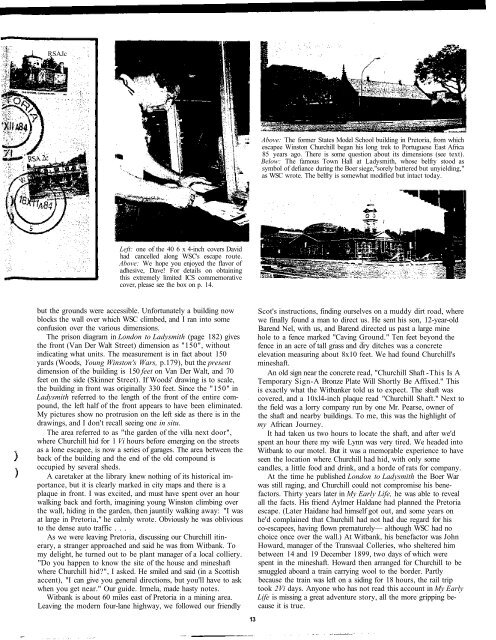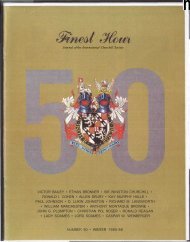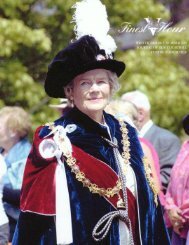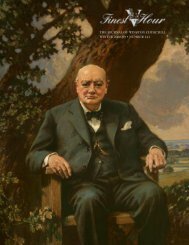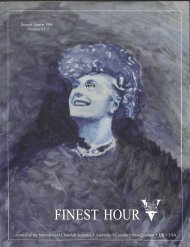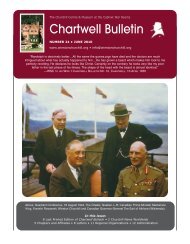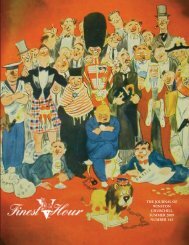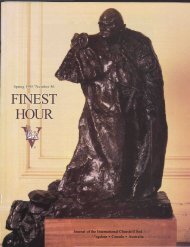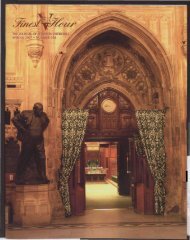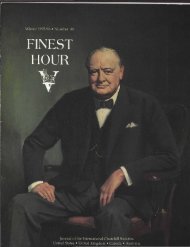Journal of the International Churchill Society - Winston Churchill
Journal of the International Churchill Society - Winston Churchill
Journal of the International Churchill Society - Winston Churchill
You also want an ePaper? Increase the reach of your titles
YUMPU automatically turns print PDFs into web optimized ePapers that Google loves.
RSAJc<br />
Above: The former States Model School building in Pretoria, from which<br />
escapee <strong>Winston</strong> <strong>Churchill</strong> began his long trek to Portuguese East Africa<br />
85 years ago. There is some question about its dimensions (see text).<br />
Below: The famous Town Hall at Ladysmith, whose belfry stood as<br />
symbol <strong>of</strong> defiance during <strong>the</strong> Boer siege,"sorely battered but unyielding,"<br />
as WSC wrote. The belfry is somewhat modified but intact today.<br />
Left: one <strong>of</strong> <strong>the</strong> 40 6 x 4-inch covers David<br />
had cancelled along WSC's escape route.<br />
Above: We hope you enjoyed <strong>the</strong> flavor <strong>of</strong><br />
adhesive, Dave! For details on obtaining<br />
this extremely limited ICS commemorative<br />
cover, please see <strong>the</strong> box on p. 14.<br />
S.S&.<br />
but <strong>the</strong> grounds were accessible. Unfortunately a building now<br />
blocks <strong>the</strong> wall over which WSC climbed, and I ran into some<br />
confusion over <strong>the</strong> various dimensions.<br />
The prison diagram in London to Ladysmith (page 182) gives<br />
<strong>the</strong> front (Van Der Walt Street) dimension as "150", without<br />
indicating what units. The measurement is in fact about 150<br />
yards (Woods, Young <strong>Winston</strong>'s Wars, p.179), but <strong>the</strong> present<br />
dimension <strong>of</strong> <strong>the</strong> building is 150 feet on Van Der Walt, and 70<br />
feet on <strong>the</strong> side (Skinner Street). If Woods' drawing is to scale,<br />
<strong>the</strong> building in front was originally 330 feet. Since <strong>the</strong> "150" in<br />
Ladysmith referred to <strong>the</strong> length <strong>of</strong> <strong>the</strong> front <strong>of</strong> <strong>the</strong> entire compound,<br />
<strong>the</strong> left half <strong>of</strong> <strong>the</strong> front appears to have been eliminated.<br />
My pictures show no protrusion on <strong>the</strong> left side as <strong>the</strong>re is in <strong>the</strong><br />
drawings, and I don't recall seeing one in situ.<br />
The area referred to as "<strong>the</strong> garden <strong>of</strong> <strong>the</strong> villa next door",<br />
where <strong>Churchill</strong> hid for 1 Vi hours before emerging on <strong>the</strong> streets<br />
as a lone escapee, is now a series <strong>of</strong> garages. The area between <strong>the</strong><br />
back <strong>of</strong> <strong>the</strong> building and <strong>the</strong> end <strong>of</strong> <strong>the</strong> old compound is<br />
occupied by several sheds.<br />
A caretaker at <strong>the</strong> library knew nothing <strong>of</strong> its historical importance,<br />
but it is clearly marked in city maps and <strong>the</strong>re is a<br />
plaque in front. I was excited, and must have spent over an hour<br />
walking back and forth, imagining young <strong>Winston</strong> climbing over<br />
<strong>the</strong> wall, hiding in <strong>the</strong> garden, <strong>the</strong>n jauntily walking away: "I was<br />
at large in Pretoria," he calmly wrote. Obviously he was oblivious<br />
to <strong>the</strong> dense auto traffic . . .<br />
As we were leaving Pretoria, discussing our <strong>Churchill</strong> itinerary,<br />
a stranger approached and said he was from Witbank. To<br />
my delight, he turned out to be plant manager <strong>of</strong> a local colliery.<br />
"Do you happen to know <strong>the</strong> site <strong>of</strong> <strong>the</strong> house and mineshaft<br />
where <strong>Churchill</strong> hid?", I asked. He smiled and said (in a Scottish<br />
accent), "I can give you general directions, but you'll have to ask<br />
when you get near." Our guide. Irmela, made hasty notes.<br />
Witbank is about 60 miles east <strong>of</strong> Pretoria in a mining area.<br />
Leaving <strong>the</strong> modern four-lane highway, we followed our friendly<br />
Scot's instructions, finding ourselves on a muddy dirt road, where<br />
we finally found a man to direct us. He sent his son, 12-year-old<br />
Barend Nel, with us, and Barend directed us past a large mine<br />
hole to a fence marked "Caving Ground." Ten feet beyond <strong>the</strong><br />
fence in an acre <strong>of</strong> tall grass and dry ditches was a concrete<br />
elevation measuring about 8x10 feet. We had found <strong>Churchill</strong>'s<br />
mineshaft.<br />
An old sign near <strong>the</strong> concrete read, "<strong>Churchill</strong> Shaft -This Is A<br />
Temporary Sign-A Bronze Plate Will Shortly Be Affixed." This<br />
is exactly what <strong>the</strong> Witbanker told us to expect. The shaft was<br />
covered, and a 10xl4-inch plaque read "<strong>Churchill</strong> Shaft." Next to<br />
<strong>the</strong> field was a lorry company run by one Mr. Pearse, owner <strong>of</strong><br />
<strong>the</strong> shaft and nearby buildings. To me, this was <strong>the</strong> highlight <strong>of</strong><br />
my African Journey.<br />
It had taken us two hours to locate <strong>the</strong> shaft, and after we'd<br />
spent an hour <strong>the</strong>re my wife Lynn was very tired. We headed into<br />
Witbank to our motel. But it was a memorable experience to have<br />
seen <strong>the</strong> location where <strong>Churchill</strong> had hid, with only some<br />
candles, a little food and drink, and a horde <strong>of</strong> rats for company.<br />
At <strong>the</strong> time he published London to Ladysmith <strong>the</strong> Boer War<br />
was still raging, and <strong>Churchill</strong> could not compromise his benefactors.<br />
Thirty years later in My Early Life, he was able to reveal<br />
all <strong>the</strong> facts. His friend Aylmer Haldane had planned <strong>the</strong> Pretoria<br />
escape. (Later Haidane had himself got out, and some years on<br />
he'd complained that <strong>Churchill</strong> had not had due regard for his<br />
co-escapees, having flown prematurely— although WSC had no<br />
choice once over <strong>the</strong> wall.) At Witbank, his benefactor was John<br />
Howard, manager <strong>of</strong> <strong>the</strong> Transvaal Colleries, who sheltered him<br />
between 14 and 19 December 1899, two days <strong>of</strong> which were<br />
spent in <strong>the</strong> mineshaft. Howard <strong>the</strong>n arranged for <strong>Churchill</strong> to be<br />
smuggled aboard a train carrying wool to <strong>the</strong> border. Partly<br />
because <strong>the</strong> train was left on a siding for 18 hours, <strong>the</strong> rail trip<br />
took 2Vi days. Anyone who has not read this account in My Early<br />
Life is missing a great adventure story, all <strong>the</strong> more gripping because<br />
it is true.<br />
13


